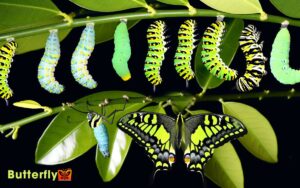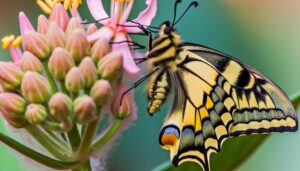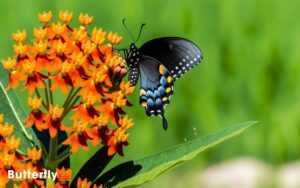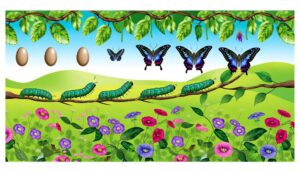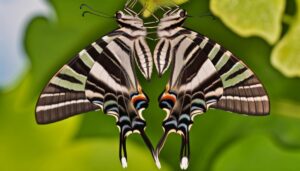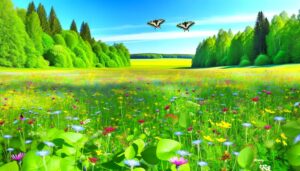Are Black Swallowtail Butterflies Common in Maine? Discover!
Black Swallowtail butterflies, Papilio polyxenes, are indeed common in Maine, having been part of the state’s ecosystem for centuries.
These butterflies are easily identified by their black wings adorned with yellow spots, and blue and red markings near the tail. They frequent habitats rich in host plants like parsley, dill, and fennel, and their numbers fluctuate with environmental changes.Active from late spring to September, Black Swallowtails exhibit resilience and long-term stability despite climatic challenges.
Conservation efforts focus on habitat preservation and public awareness, helping maintain their presence. Discover more about their fascinating life cycle and ecological impact.
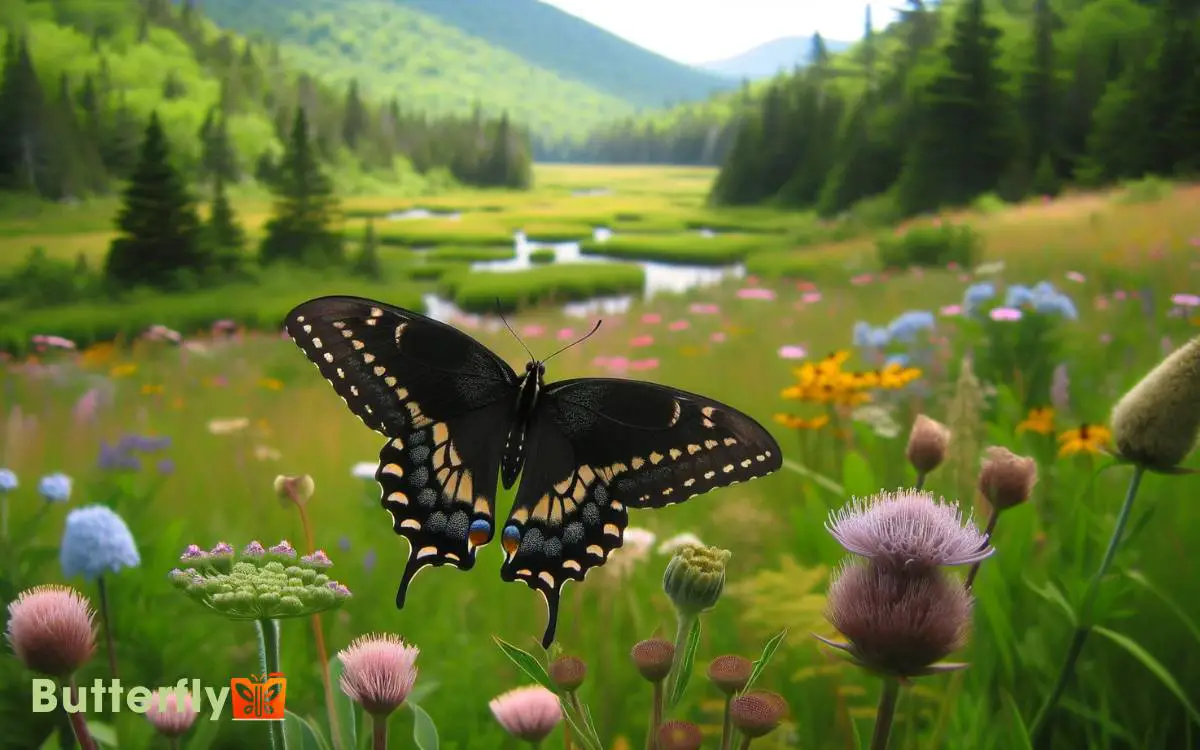
Key Takeaways
Identification of Black Swallowtails
The Black Swallowtail butterfly, scientifically known as Papilio polyxenes, can be identified by its distinct black wings adorned with two rows of yellow spots and a series of blue and red markings near the tail.
This striking coloration serves as a deterrent to predators, mimicking the toxic Pipevine Swallowtail.
Adult males and females exhibit sexual dimorphism; males display more pronounced yellow bands, while females boast intensified blue areas on their hindwings.
Caterpillars, initially black with white bands, transform to vibrant green with black and yellow spots as they mature.
Such detailed identification markers not only highlight the butterfly’s unique beauty but also assist enthusiasts in distinguishing them from similar species, fostering a deeper connection with nature’s intricacies.
Historical Presence in Maine
Historical records show that Black Swallowtail butterflies have been part of Maine’s ecosystem for centuries, thriving in the state’s diverse habitats. Entomologists have documented their presence since the early 1800s, noting their adaptability to Maine’s climatic conditions.
Specimen collections from various natural history museums confirm sightings across multiple counties, suggesting a well-established population. Studies indicate that these butterflies have consistently found ecological niches, benefiting from Maine’s rich flora.
Historical data also highlight fluctuations in their numbers, likely linked to environmental changes and agricultural practices. Despite these fluctuations, Black Swallowtails have shown remarkable resilience, maintaining a persistent presence.
This long-term stability underscores their ability to adapt and survive, integral to Maine’s natural heritage.
Preferred Habitats
Black Swallowtail butterflies in Maine show a strong preference for habitats rich in specific host plants like parsley, dill, and fennel, which are essential for their larval stages.
They also require environments abundant in nectar sources such as milkweed and clover to sustain their adult population.
These habitat preferences underline the importance of plant diversity in supporting their life cycle and population stability.
Host Plants Selection
When selecting host plants, Black Swallowtail butterflies in Maine show a strong preference for members of the Apiaceae family, particularly parsley, dill, and fennel. These plants provide essential nutrients for the larvae, ensuring their development into healthy adults.
The chemical compounds found in these host plants deter predators, offering a natural defense mechanism for the caterpillars. Black Swallowtail females meticulously lay their eggs on the undersides of these leaves, optimizing the larvae’s chances of survival.
The availability of these plants greatly influences the distribution and abundance of Black Swallowtails in Maine.
By prioritizing the Apiaceae family, these butterflies exhibit a finely tuned evolutionary strategy that enhances their reproductive success and resilience in diverse environmental conditions.
Nectar Sources Availability
The availability of diverse nectar sources in Maine’s habitats plays an essential role in supporting the energy needs and reproductive success of Black Swallowtail butterflies.
These butterflies rely on various flowering plants to sustain their high metabolic demands. Maine’s rich floral diversity guarantees that nectar is available throughout their active months.
Key nectar sources include:
- Milkweed: Essential for monarchs, also attracts swallowtails.
- Clover: Abundant and accessible, supports many pollinators.
- Thistle: Rich in nectar, attracts numerous butterflies.
- Goldenrod: Late-season bloom, crucial for fall sustenance.
- Wildflowers: Diverse species offer continuous nectar supply.
This floral variety not only fosters butterfly populations but also enriches the ecosystem’s overall health and biodiversity.
Seasonal Appearances
Throughout Maine, observers will notice that Black Swallowtail butterflies typically emerge from their chrysalises in late spring, marking the beginning of their active season. They thrive from May through September, making the most of Maine’s favorable climate.
During this period, they can be seen fluttering around gardens, meadows, and open fields, feeding on nectar from various flowers. Their activity peaks in mid-summer, around July, when temperatures are ideal.
By late summer, these butterflies start preparing for overwintering, with the final generation entering diapause as chrysalises. This seasonal cycle ensures their survival through Maine’s harsh winters.
Observing these patterns offers insights into their adaptation strategies and enhances appreciation of their role in the ecosystem.
Breeding Patterns
Black Swallowtail Butterflies in Maine exhibit distinct breeding patterns. Mating typically occurs in late spring and early summer. Females strategically lay their eggs on host plants like dill and parsley. This ensures that larvae have immediate access to food.
This timing and selection maximizes the survival rate of the offspring, aligning with the region’s climatic conditions.
Mating Season Timing
In Maine, the mating season for Black Swallowtail butterflies generally begins in late spring and continues through the summer, driven by a combination of temperature, daylight, and availability of host plants.
These environmental factors create ideal conditions for mating and the subsequent laying of eggs.
Male Black Swallowtails actively patrol open areas, seeking receptive females. Courtship behaviors are intricate, involving aerial displays and chemical signals.
The timing guarantees that larvae will have abundant food sources, aligning their development with the peak growth periods of host plants.
- Late spring’s gentle warmth invites new beginnings.
- Long summer days offer endless possibilities.
- Rich greenery provides sustenance and shelter.
- Majestic flights showcase their elegance.
- Nature’s synchrony guarantees survival and continuity.
This delicate balance underscores the species’ resilience and adaptability.
Egg Laying Habits
Following the intricate courtship, female Black Swallowtail butterflies meticulously select host plants to lay their eggs, ensuring the larvae have the best resources for growth. They prefer plants in the Apiaceae family, such as dill, parsley, and fennel.
This deliberate selection maximizes larval survival and development. Eggs are usually laid singly on the underside of the leaves, providing protection from predators and environmental elements.
| Host Plant | Egg Laying Preference |
|---|---|
| Dill | High |
| Parsley | High |
| Fennel | Moderate |
| Queen Anne’s Lace | Moderate |
Females demonstrate a keen instinct, choosing locations that balance accessibility and safety. Their choices reflect an evolutionary strategy aligned with the nutritional needs and safety of their offspring, showcasing nature’s intricate balance.
Population Trends
Recent studies indicate that the population trends of Black Swallowtail butterflies in Maine have shown significant fluctuations over the past decade.
Researchers have observed a variety of factors contributing to these changes, including habitat loss, pesticide use, and variations in food plant availability.
These fluctuations are critical as they reveal the delicate balance within the ecosystem and the butterfly’s role in it.
- Dramatic population declines observed in 2015
- A surprising resurgence in 2017
- Continuous threats from agricultural practices
- Increased public awareness and conservation efforts
- Hopeful signs of stabilization in recent years
Understanding these trends helps conservationists develop effective strategies to protect and sustain Black Swallowtail populations, ensuring these butterflies continue to flutter freely across Maine’s landscapes.
Impact of Climate
Climate variability profoundly influences the Black Swallowtail butterflies in Maine, affecting their life cycles, migration patterns, and habitat suitability. As temperatures rise, butterflies may shift their range northward, seeking cooler climates.
Changes in precipitation patterns also impact the availability of host plants essential for larval development. Increased frequency of extreme weather events can disrupt migration and reduce the survival rates of these butterflies.
| Climate Factor | Impact on Black Swallowtails |
|---|---|
| Rising Temperatures | Northward range shift |
| Precipitation Changes | Altered host plant availability |
| Extreme Weather | Disrupted migration and lower survival |
| Seasonal Variability | Misalignment of life cycle stages |
Understanding these factors helps predict how climate change will affect their populations, ensuring proactive conservation strategies.
Food Sources
Black Swallowtail butterflies in Maine rely primarily on a variety of host plants and nectar sources for nourishment, which are essential for both their larval and adult stages. Larvae often feed on plants in the carrot family, such as Queen Anne’s lace, parsley, and dill.
Adults, on the other hand, seek nectar from a range of flowering plants, ensuring they get the necessary energy for flight and reproduction. The availability of these food sources directly impacts their survival and ability to thrive in Maine.
- Vibrant wildflowers that paint Maine’s landscapes
- Fragrant herbs that nurture both larvae and butterflies
- The delicate balance of Maine’s ecosystems
- The freedom of butterflies fluttering in the breeze
- The intricate dance of pollination and growth
This interconnected web of flora and fauna highlights the importance of preserving their habitats.
Are Black Swallowtail Butterflies Common in Other Northeastern States Like Maine?
Yes, the black swallowtail butterflies presence in new york is not limited to just the state of New York. They are also commonly found in other northeastern states like Maine. Their striking appearance and graceful flight make them a beautiful sight to behold in various regions of the Northeast.
Conservation Efforts
Conservation efforts for Black Swallowtail butterflies in Maine focus on habitat preservation initiatives and public awareness campaigns. These initiatives aim to protect critical breeding and feeding grounds by promoting sustainable land use practices.
Concurrently, public awareness campaigns educate the community on the importance of these butterflies, encouraging local involvement in conservation activities.
Habitat Preservation Initiatives
To safeguard the survival of Black Swallowtail butterflies in Maine, local conservationists are implementing targeted habitat preservation initiatives that focus on protecting and restoring native plant species essential for the butterflies’ lifecycle.
These efforts are grounded in scientific research showing that the butterflies rely on specific host plants like Queen Anne’s lace and parsley for laying eggs and feeding larvae.
By promoting the growth of these plants, conservationists aim to create a sustainable environment for the butterflies.
- Preserving wildflower meadows to guarantee a rich supply of nectar.
- Restoring wetlands to support diverse ecosystems.
- Planting native host plants to provide larval food sources.
- Monitoring butterfly populations to track conservation success.
- Reducing pesticide use to protect sensitive insect communities.
These initiatives are vital for the butterflies’ continued existence.
Public Awareness Campaigns
In parallel with habitat preservation efforts, local conservationists are launching public awareness campaigns to educate the community about the importance of protecting Black Swallowtail butterflies and their ecosystems.
These campaigns focus on disseminating scientific knowledge through workshops, social media, and community events.
They highlight the butterfly’s role in pollination and its vulnerable lifecycle stages. By providing practical tips on creating butterfly-friendly gardens and reducing pesticide use, these initiatives empower individuals to take actionable steps.
The campaigns also emphasize the interconnectedness of species and ecosystems, fostering a sense of responsibility and freedom in making conservation choices.
This multifaceted approach aims to cultivate a well-informed public ready to contribute to the preservation of Maine’s biodiversity.
How to Spot Them
Observing Black Swallowtail butterflies in Maine requires keen attention to their distinct wing patterns, characterized by striking black and yellow markings.
Their forewings display black with two rows of yellow spots, while the hindwings feature iridescent blue crescents and a single red spot near the tail.
These butterflies are often found in open fields, gardens, and meadows. To effectively spot them, consider the following:
- Look during warm, sunny days: They’re most active in bright sunlight.
- Check around host plants: Parsley, dill, and fennel are favorites.
- Observe flight patterns: They’ve a unique, fluttering flight.
- Search in late spring to early fall: This is their peak season.
- Note their size: They’ve a wingspan of 3 to 4 inches.
Conclusion
To sum up, the black swallowtail butterfly’s dance across Maine’s landscapes highlights its adaptability and resilience. Historical records coupled with ongoing observations confirm their established presence. Their ability to thrive in diverse habitats, from gardens to meadows, showcases their ecological significance. Enthusiasts often wonder, how rare is a black butterfly, and while entirely black specimens are uncommon, the black swallowtail’s striking patterns make it a frequent sight in Maine. This enduring presence reflects both the species’ survival skills and the region’s supportive environment.
While climate shifts and habitat preferences play significant roles, conservation efforts remain pivotal. By understanding their breeding patterns and food sources, enthusiasts can better spot these majestic insects.
Truly, the black swallowtail is a manifestation of nature’s intricate tapestry, fluttering through the Pine Tree State with grace and tenacity.

